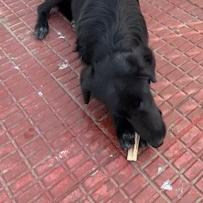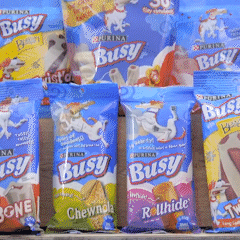Beware the dog!
Beware the dog!
Don’t free it, it may dig holes all around the garden.
Don’t free it, it may dig holes all around the garden.
This sign was spotted on the fence of a kennel situated in a garden that housed a dog who had a noticeably dirty nose full of soil. In its surroundings, there was proof of the dog being caged: A whole collection of freshly dug holes, some of which appeared to contain leftover food mostly consisting of chicken and beef bones.
Humans often bury their valuables underground.
Similarly, dogs have exhibited a similar tendency, leading to the ground being colloquially referred to as the "dog fridge", a spot where bones from leftover human food were stored underground for later consumption, safeguarding them from other dogs. However, with the advent of commercial dry food and the establishment of twice-daily feeding routines in household kitchens, dogs' dietary preferences1 underwent a significant shift, where bones were phased out of their regular nutrition, which resulted in a “dog fridge” running low on supplies.
Although modern trends have led to a decline in the use of bones as a dietary staple for dogs, these canines continue to exhibit a predisposition when manipulating them. While attempting to dig holes, dogs will circle the targeted area, use their paws to excavate, and try to hide an item before moving on, as if a top-secret mission just took place. The difference nowadays? Instead of the untidy ground, dogs employ a comfortable blanket on a human bed as a new location for digging holes. Similarly, the once-reliable supply of leftover bones has been replaced by manufactured teeth-ergonomic snacks.
Those items, discarded by humans while still influencing dogs' instinctual behavior, prompt a reflection on the present state of dog-keeping habits. The current disposition of canine-human relationships stems from the rise of Western post-industrialized contexts, which have been characterized by an increasing prevalence of loneliness and social isolation among humans,2 demanding the emergence of new forms of affective experiences. As such, dogs have become perceived almost as emotional saviors for humans, a role that also places the dog in a fragile position that is at once dependent on human care for their survival while simultaneously being culturally represented as a figure that humans depend on to fulfill their own emotional needs:
What would happen if the dog proves inadequate emotional support? Would humans still allow them to snuggle beside their beds or even share the last scraps of their dinners?
Assuming the historical fact that dogs originated from artificial intervention,3 imposing human influence on canines is not a new phenomenon. In modern ecosystems, dogs stand out as a prominent example of multi-species living arrangements, particularly in urbanized landscapes where the presence of untamed nature is often scarce, they can be viewed as a vestige of a “wild” state4 that humans have since altered. In this context, this alteration is exemplified by the popularity of manufactured dog snacks, such as those from Purina —a well-known commercialized dog food brand— which mimics the scent and appearance of leftovers chicken and beef bones and are widely embraced in contrast to discarded bones, which are even considered an enemy5 for dogs’ nutrition.Fig.1
1
Businessman James Spratt introduced the first commercially-prepared pet food in England in approximately 1860 influenced by the dry biscuit sailors ate on long trips. He called them “Spratt’s Meat Fibrine Dog Cakes” and they contained a mix of blended wheat, vegetables, beetroot, and “the dried unsalted gelatinous parts of Prairie Beef”
Zeller, Jon, Lisa Dunn, and The Farmer's Dog. “History of Commercial Pet Food: A Great American Marketing Story.” The Farmer's Dog, January 13, 2023.
2
The sentimentalized view of pets was developed in Western Europe in the 19th Century and, later, in North America (1984). Humans needed an outlet for their gestures of affection[as] this was becoming more difficult to find in modern society as it began to segment and isolate people into their private spheres.
Andreozzi, Matteo. “Humans’ Best Friend? the Ethical Dilemma of Pets.” Relations, no. 2 (2013): 23–35.
3
Coming from the 15.000 years of the dog-invention process. Dogs would have never existed out of the manipulations that emerged from our ancestors, in which the actions of feeding, breeding, and spreading allowed a human-led wolf selective movement that resulted in what today are called dogs.
Saletan, William. “Our Creepiest Genetic Invention: The Dog.” Slate Magazine. Slate. Accessed August 14, 2022
4
About the wild-domestic transition of the pet: The pet represents the transition of animal contact from uncontrolled spaces known as the of wild and controlled spaces like circuses and zoos into disciplined spaces of home and hearth.
Halberstam, Jack. Wild Things: The Disorder of Desire (Durham: Duke University Press, 2020)
5
Illnesses such as gastrointestinal obstruction, choking, cuts, wounds in the mouth or on the tonsils, vomiting, diarrhea, bleeding from the rectum, and even death (with approximately fifteen reported cases of dogs dying after consuming bone treats) are reasons why bones should not be given to dogs.
Commissioner, Office of the. “No Bones (or Bone Treats) about It: Reasons Not to Give Your Dog Bones.” U.S. Food and Drug Administration. FDA. Accessed February 19, 2023


Fig.1
On the left, dog eating a human leftover beef bone. On the right, dogs eating jerky-wraps, one of the bone-shaped snacks of Purina for small-medium dogs with a cost of 13€ for a bag of 4 pieces, featuring real beef hide wrapped in a strip of real chicken jerky (Purina. “Busy Jerky Wraps Dog Treats.” Purina. Accessed February 19, 2023)
However, the case of the bone is not an isolated incident, it just shows how a dog’s relationship with humans is characterized by ambiguity.
Dogs are often criticized for biting and scratching but excused when they nip and chew. Similarly, they are allowed to whimper or purr but not to bark or whine.6 This inconsistency in human attitudes towards dogs underscores the unsettled state in which dogs currently exist, where they are compelled to live in a world that suppresses and forbids their natural inclinations.7
6
In this zombie economy, the pet survival depends on its ability to answer to our anthropomorphic call for companionability in the forms we mandate—a pet can nip and chew but not bite and scratch; it can whimper or purr but should not bark or whine; a pet must learn obedience and eat and shit when we say, and it must adapt to a carceral reality in exchange for not being eaten.
Halberstam, Jack. Wild Things: The Disorder of Desire (Durham: Duke University Press, 2020)
7
Canids, including domesticated dogs and their wolf ancestors, possess an intrinsic inclination to express themselves through diverse forms of vocalization, such as barks, yelps, woofs/coughs, yips, screams, growls, coos, howls, mews, and grunts. Regrettably, humans regard barking as a prominent cause of noise pollution, leading to punitive actions against dogs. As a result, sometimes extreme measures such as "debarking," which involves surgically altering a dog's vocal cords to diminish barking, are put in practice to “combat” this issue.
Pongrácz, Péter, Csaba Molnár, and Ádám Miklósi. “Barking in Family Dogs: An Ethological Approach.” The Veterinary Journal 183, no. 2 (2010): 141–47
In this zombie economy, the pet survival depends on its ability to answer to our anthropomorphic call for companionability in the forms we mandate—a pet can nip and chew but not bite and scratch; it can whimper or purr but should not bark or whine; a pet must learn obedience and eat and shit when we say, and it must adapt to a carceral reality in exchange for not being eaten.
Halberstam, Jack. Wild Things: The Disorder of Desire (Durham: Duke University Press, 2020)
7
Canids, including domesticated dogs and their wolf ancestors, possess an intrinsic inclination to express themselves through diverse forms of vocalization, such as barks, yelps, woofs/coughs, yips, screams, growls, coos, howls, mews, and grunts. Regrettably, humans regard barking as a prominent cause of noise pollution, leading to punitive actions against dogs. As a result, sometimes extreme measures such as "debarking," which involves surgically altering a dog's vocal cords to diminish barking, are put in practice to “combat” this issue.
Pongrácz, Péter, Csaba Molnár, and Ádám Miklósi. “Barking in Family Dogs: An Ethological Approach.” The Veterinary Journal 183, no. 2 (2010): 141–47
In this sense, Beware of dog! is presented as an investigation that contributes to rechallenge the dichotomy inherent in the current conditions of dog-keeping practices. Whether it is via Youtube’s showcase, dog marriage services, AI image generators, or activism discourses, these tools support the construction of a methodology that employs both visual and descriptive approaches to examine dog-human interactions and observations. By defamiliarizing common and often overlooked aspects of dogs' daily routines, this study aims to provide fresh and informative insights into their experiences, benefiting not only from an extra dose of colloquial language but also from the narrator’s hybrid position.
The narrator’s dual role is shaped by a twelve-year engagement with “four-legged rather than two” creatures, and active participation in dog stray movements across animal organizations in Europe and Africa. This experience has endowed the narrator with a comprehensive understanding of the diverse realities of those animals, filtered through the lenses of two key roles: that of an identifier and an agitator. As an identifier, the narrator analyzes the conventional contexts within which dogs are situated, while as an agitator, it challenges and unveils these contexts by presenting its findings.
Ultimately, the study culminates in the production of the three independent stories “Good Bella! Here is a treat for you” and a pat on the back too”, “Missing flowers in the “unconditional loving” of Marryyourpet.com” and “The multifaceted “big black nanny Pitbull,” such an expert on the discarded spectacle”. These titles serve not only to illustrate human-led examples of affection and dominance towards real dog stories but also as catalysts for subverting preconceived notions of dogs that extend anthropocentric perspectives.
Beware the dog!
